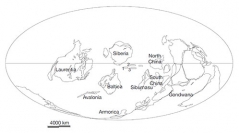

 Geodiversitas
28 (3) - Pages 433-446
Geodiversitas
28 (3) - Pages 433-446Statistical comparisons, based on 173 genera distributed in 27 Caradoc localities from around the world, show strong faunal similarities between North and South China and the Chu-Ili terrane, the Chingiz terrane and Australia/Tasmania. The Scoto-Appalachian fauna of the Laurentian terrane shows closer similarities to faunas from the Gornoi-Altai terrane (belonging to the Kazakhstan terrane) than to faunas from Baltica and Avalonia that are generally regarded as being closer to Laurentia. This suggests a peri-equatorial location for the Gornoi-Altai terrane that would allow the migration of taxa to the west. The faunas from North and South China are typical deep water Foliomena faunas that are restricted to peri-equatorial palaeo-latitudes. The North China terrane is best positioned closer to the Equator than other palaeogeographical reconstructions suggest. The three different Kazakhstan terranes group each with a different cluster (i.e. the Gornoi-Altai terrane with Laurentia, the Chu-Ili terrane with North and South China and the Chingiz terrane with the Australian, including Tasmania, part of Gondwana). This suggests that Kazakhstan is best regarded as having been divided into several terranes, each possessing an individual developing history, rather than a single entity.
Brachiopoda, Caradoc, Ordovician, palaeogeography, provinciality